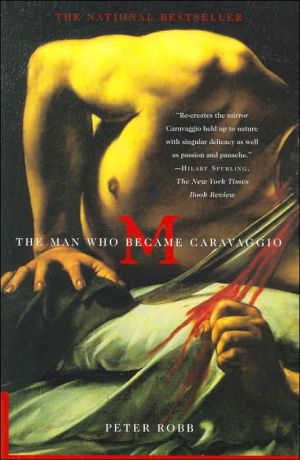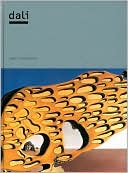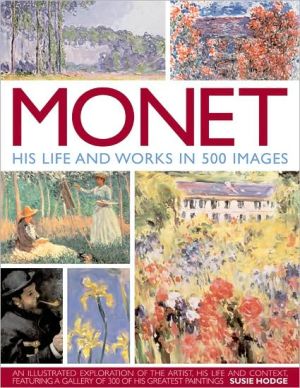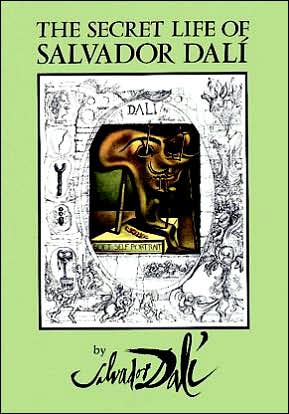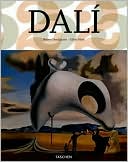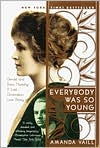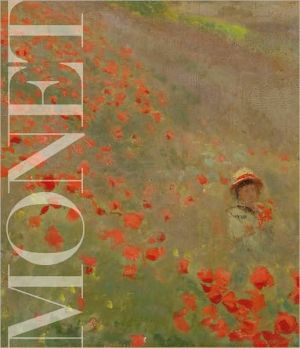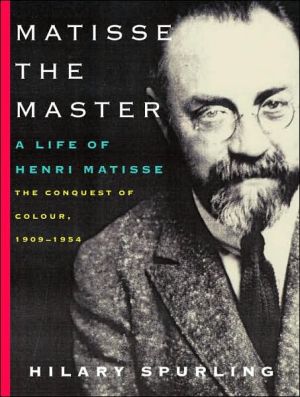M: The Man Who Became Caravaggio
A New York Times Notable Book of the Year\ As vividly and unflinchingly presented herein with "blood and bone and sinew" (Times Literary Supplement) by Peter Robb, Caravaggio's wild and tempestuous life was a provocation to a culture in a state of siege. The end of the sixteenth century was marked by the Inquisition and Counter-Reformation, a background of ideological war against which, despite all odds, brilliant feats of art and science were achieved. No artist captured the dark, violent...
Search in google:
A bold, fresh biography of the world's first modern painter As presented with "blood and bone and sinew" (Times Literary Supplement) by Peter Robb, Caravaggio's wild and tempestuous life was a provocation to a culture in a state of siege. The of the sixteenth century was marked by the Inquisition and Counter-Reformation, a background of ideological cold war against which, despite all odds and at great cost to their creators, brilliant feats of art and science were achieved. No artist captured the dark, violent spirit of the time better than Caravaggio, variously known as Marisi, Moriggia, Merigi, and sometimes, simply M. As art critic Robert Hughes has said, "There was art before him and art after him, and they were not the same."Caravaggio threw out Renaissance dogma to paint with dazzling originality and fierce vitality, qualities that are echoed in Robb's prose. As with Caravaggio's art, M arrests and susps time to reveal what the author calls "the theater of the partly seen." Caravaggio's wild persona leaps through these pages like quicksilver; in Robb's skilled hands, he is an immensely attractive character with an astonishing connection to the glories and brutalities of life.Publishers WeeklyRecognized now as a peer of 17th-century masters Rembrandt and Vermeer, Michelangelo Merisi da Caravaggio (1571-1610) painted notoriously provocative religious and classical tableaux, yet left few traces ("no letters, no table talk, no notebook or treatise") of his life beyond his art. Australian -born Robb, whose ex-pat tour-de-force Midnight in Sicily: On Art, Food, History, Travel, & La Cosa Nostra took readers through that fascinating island, has created an idiosyncratic but dazzling biography of Caravaggio by exploiting almost every extant fragment, including a handful of sightings by friends and enemies, and the scanty Italian police files. More audaciously, Robb spreads through the life many pages on every known canvas, leaving appropriately theatrical description in his wake. Robb's Caravaggio--or "M," as he insists on calling the multimonikered and aliased painter--was a violent man of "hairtrigger touchiness," who fueled the passionate intensity of his painting with his professional and emotional frustrations, managing to register raw life in a religious culture that demanded, according to Robb, vapid holiness. Bisexual, he painted and loved pubescent boys, and patronized the female prostitutes he used as models. To great effect, Robb inserts reflections by the painter's contemporaries within his own sentences, offsetting them with italics rather than quotation marks: "M's repeated and humiliating requests for small advances from Masetti confirmed the need. That wasn't his style and he reddens whenever he sees me." He studs his own descriptions with odd words, obscenities and anachronistic, out-of-place contemporary references ("... like Ronald Reagan playing the cowboy"). Yet it all works--Robb's flawed, melodramatic, swollen biography is crammed with more about the dark, driven Caravaggio than any previous life. Just as Caravaggio took art to the edge, Robb takes biography there. 16 pages of illus., 8 in color, not seen by PW. (Feb.) Copyright 1999 Cahners Business Information.
\ \ \ \ \ Chapter One\ \ \ MILAN & CARAVAGGIO 1571-1592\ ROME 1592-1593\ \ \ \ Boy peeling fruit\ Sick self portrait\ \ \ \ ON 14 JANUARY 1571 Francesco Sforza da Caravaggio, who was maybe not yet twenty, attended the wedding of an employee who was ten or so years older than himself. Out of personal liking and respect, the young marchese of Caravaggio was the formal witness to the marriage of Fermo Merisi, his household administrator, overseer and architect. Merisi's family like his wife's came from the small town of Caravaggio, thirty kilometres east of Milan on the Lombard plain. The marchese's sixteen year old wife Costanza was likely also at the celebration. Fermo Merisi lived, like the marchese of Caravaggio, in Milan. He was a young widower, and already had a daughter called Margherita. He was now marrying the twenty one year old daughter of a rather well off local family with property in the district, Lucia Aratori. In the next few years they had four children. No birth or baptism record was ever found for the eldest, but the birth day of the second Merisi son was recorded in Milan as 21 November 1572, and in later legal records of the family Giovan Battista Merisi was always noted as being a year younger than his brother M. There was a daughter, Caterina, born in 1574 and a third boy Giovan Pietro died still a child in 1588.\ None of the Merisi children were listed in the baptismal records in Caravaggio. They were likely all born in Milan, where Fermo Merisi rented rooms from 1563 until his death, not far from the Sforza da Caravaggio palaceof his protector in the parish of santa Maria della Passerella. A four year gap in the parish's records ended on 20 October 1571, nine months and a few days after the Merisi—Aratori marriage. So M was born just before this. September 29 was the day of saint Michael, the archangel, and M from Caravaggio was almost certainly born in Milan on 29 September 1571, since M's birth day was most likely his name day, as Rubens was called Peter Paul when he was born on June 29 six years later, the day of Peter and Paul. And there was another reason for thinking of Michael the avenging archangel on the day Fermo Merisi's first son was born.\ \ \ And there was war in heaven: Michael and his angels fought against the dragon; and the dragon fought, and his angels, and prevailed not; neither was their place found any more in heaven. And the great dragon was cast out, that old serpent, called the Devil, and Satan, which deceiveth the whole world: he was cast out into the earth, and his angels were cast out with him.\ \ \ On earth it was naval war in the Mediterranean between Christians and infidels. The late summer of 1571 culminated in the battle of Lepanto, Christian victory at sea over Islam. That meant glory for the young marchesa Costanza's father. Marcantonio Colonna was the admiral of the papal fleet and head of the oldest and most powerful family of the Roman aristocracy. His daughter's anxiety was at its height when the first Merisi child was born, and triumphantly resolved at sea a week later, when M most likely got his Christian name. The first Merisi boy was born less than two years after Francesco Sforza's own first son. The Sforzas had been the great dynasty of Milan, the Sforzas of Caravaggio a lesser line — the marriage of Francesco and Costanza had begun badly, when he was sixteen and randy and she was twelve and terrified of sex, but it resolved in unexpected consummation a year or so later. Costanza had six children and was made a widow young, when M was still a child — Francesco Sforza died in 1583 and the marchesa Costanza was left to run the Caravaggio estate and bring up the children on her own, with Fermo and Lucia Merisi's young family growing close nearby. A tough and resourceful young widow who ran the estate on her own while her eldest boy Muzio was growing up at the Spanish court in Madrid and the others were children, the marchesa Costanza likely saw the boy M often. Years later she and her family would be closely involved in his fate.\ Caravaggio was a quiet place with a single claim to fame. On a spring day in 1432, a peasant girl saw the virgin Mary in the fields outside the town. A spring of fresh water had welled up from the ground where she appeared. A church was built on the spot, but in the fifteen seventies, the original church seemed too small and plans were drawn up for a vaster and more grandiose sanctuary with a cupola nearly sixty five metres high and an interior nearly a hundred metres long. Work started in 1575 and went on until the eighteenth century. An uncle of M's was one of the first contractors for the building, and M had cousins working on it too. There were lots of Merisis in Caravaggio, and Fermo's family was distinguished from the others by the nickname Quacchiato. The sanctuary, and the pilgrim traffic it brought, were the biggest and liveliest things about Caravaggio and they hardly impinged on the sleepy rhythm of the town's life. It'd begun as a fortified outpost of the Romans, and since the middle ages had been — despite the odd violent passage of control from Bergamo to Cremona to Milan to Venice, until it was finally wrenched back to Milan by the Sforzas — a quietly prosperous and devoutly right thinking agricultural centre, mainly given over to the cultivation of mulberry trees for silkworms, introduced by Ludovico il Moro, whose name also meant mulberry and who made silk textiles Milan's first industry. Caravaggio's other specialty was growing melons. The sober, regular decency of it all, with the grid of solid, dourly uniform, unpretentious buildings and flat rich land of the Lombardy plain stretching almost endlessly all around in the heavy air, had little to offer impatience or ambition. You'd've had to have quite a stake in the place to stay.\ \ \ MILAN WAS DIFFERENT. A few hours' ride away, Milan was drama and violence. Milan was governed by Spain and stood on the overland route from the rest of Europe to the Italian peninsula. Milan was close to dangerously protestant France, Spain's rival as the European power. It was on the way from Spain to the Netherlands — in armed revolt against Spanish rule — and on the way from Spain to Austria and the central European part of the Hapsburg empire. It was on the way to the Spanish dominions of Naples and Sicily. Spain had to control Milan and kept a garrison of seven hundred soldiers and heavy artillery in the castle above the heavily fortified city. The Milanese themselves were always complaining about the violent and unruly presence of the Spanish soldiery stationed among them. And about the economic damage done by the military's demand for food and provisions at below cost prices and the extortion of soldiers' pay from the city authorities. Military expenses kept wealthy, industrious business minded Milan in the red and drained more money from the badly bleeding economy of imperial Spain.\ Milan was a frontline city for Rome too. Spain's anxiety over France was the political face of Rome's fear of the protestant menace from the north. The cutting edge of the catholic counter offensive was Milan's austere and fanatical archbishop, the beak nosed, hollow eyed, blue jawed cardinal Carlo Borromeo, who went around with his own squad of armed enforcers. Borromeo called them his armed family, and used them to face down the Spanish military, whose power he was challenging. Borromeo's enemies weren't only the Spanish. The Milanese senate claimed he'd turned God against Milan, since the normally fertile region of Lombardy had been stricken by a series of crop failures and famines since the cardinal had come to live among them. In 1569 Borromeo survived an arquebus shot in the back while celebrating vespers, in an assassination attempt by members of a religious order violently opposed to the cardinal's reforms of their corrupt and licentious lift. In 1573 Borromeo excommunicated the Spanish governor of Milan, during the furious clash over the armed family, an excommunication which the pope countermanded when the confrontation erupted into armed conflict. In 1579, when the cardinal excommunicated everyone involved in that year's carnival festivities, the pope had to remind him how great human fragility was. The lively people of Milan were caught up in such a tight network of Borromeo's dour imperatives and prohibitions that the senate feared a popular uprising. There is no moment of time ... he does not occupy, they wrote to the pope. It stayed like that until Borromeo died in 1584. That was the year the twelve year old boy called M went into a four year apprenticeship in Milan with a leading painter in the city.\ When M was five Milan was ravaged by an epidemic of the plague that reached the city from eastern Europe via Venice. There were public health warnings in April about the influx of outsiders without health clearances and about the stench of rubbish rotting in the streets. Borromeo organized prayers, sermons and street processions against the evident danger of plague and urged acts of penitence to avert the wrath of God. When the epidemic exploded at the height of summer Borromeo's answer was more processions through the city, which he led barefoot and carrying a big crucifix. The upper classes fled the city with their families. The Spanish governor of Milan denied the danger of disease and decreed heavy penalties for leaving. Then he abandoned the city himself. Between August and the end of the year ten thousand died. Carlo Borromeo stayed in the city and impressed everyone by pushing on with all the scheduled rites and processions. His own secretary died of the plague, among others in his household, but he went on attending the dying in the hospices and giving communion to the infected and insisting that all his priests do likewise. He goes every day to the hospice and wherever there are sick people, and if there's any hope it rests in him, wrote one Milanese. The epidemic came and went in waves all through the next year, and ended only in January 1578. By then a fifth of the city's people were dead.\ A census of Santa Maria della Passerella in the centre of Milan for 1576 recorded the disappearance of whole families from the parish during the epidemic, their members either dead or dying or evacuated to the country. Fermo Merisi and his wife Lucia were listed at home there, and his daughter Margherita and four year old Giovan Battista and a couple of young male servants. The unmentioned five year old M and his other two siblings were surely in Caravaggio, with his father's family or his mother's, out of reach of the epidemic. The others joined them later. The Merisi family may have been feeling out of harm's way by October 1577, when Fermo's father, the family head Bernardino, suddenly died without even time to make a will. That night Fermo died too, equally suddenly and also intestate. A few weeks earlier Fermo's brother Pietro had also died. Fermo Merisi was thirty eight. The depleted Merisi family never went back to Milan. Lucia and the children moved to her father's large house in Caravaggio. Four months later the twenty seven year old widow Lucia became the legal guardian of her four small children. She fought a yearlong legal battle to secure them the greater part of their father's and grandfather's estates. They missed out on their grandfather's big home property, but the boys did inherit three small pieces of orchard and vineyard around Caravaggio, and part of a fourth. As well, Lucia now had her own family's big house at Caravaggio, since her own father had also died.\ These were the two settings of M's childhood. Rural, familiar, pious Caravaggio and a busy Milan full of religious zealotry and businessmen and turbulent Spanish soldiery. Time in the shadow of the household whose workings his father oversaw, the castle at Caravaggio and the palace in Milan. A long epidemic of the plague, interminable for a child, and the overnight disappearance from his life of father, grandfather and uncle when he was barely six years old. Life with a young widowed mother and three smaller siblings. Somewhere along the line he got an education. Maybe the Sforza da Caravaggio family looked after the children of Fermo's widow. M's younger brother Giovan Battista went into the church. And the young boy M showed enough talent and keenness as a painter for the family to organize a four year apprenticeship in Milan when the boy was twelve and a half, when his brother was already in the seminary. Their father's brother Ludovico was a priest.\ M's apprenticeship contract was signed in Milan on 6 April 1584. By that time the boy was already at work with the painter Simone Peterzano and living in Peterzano's house in Milan, just near his old Milan home. Two neighbours from Caravaggio working in Milan stood in as signatories and in the name of M's mother Lucia undertook to pay Peterzano a total of twenty four gold scudi, the first advance payment of six scudi to be made within six months. Peterzano undertook in return to keep M in his house uninterruptedly for four years — because M was a minor — and have taught him by the end of that time all the skills he needed to paint on his own.\ Simone Peterzano signed himself titiani alumnus, pupil of Titian, and he was about as good as painters got in Milan at that time. He'd been born in Bergamo, presumably studied in Titian's Venice and had set up in Milan eleven years before he took on the apprentice M. In that dead interregnum of Italian art, when even mannerism was terminal, the century's great painters going or gone — Michelangelo dead in 1564, Titian dead in 1576, Veronese would die in 1588 and Tintoretto in 1594 — Peterzano mixed some of the terminal maniera with Lombard realism and some Venetian, if not quite Titianesque sense of light. The light faded the longer he worked in Milan. While he was teaching the young M, Peterzano's own work became noticeably more subdued and austere. Peterzano was toeing the line and it was a sound career move. The customer was always right. Peterzano's new and timely austerity of form and his newly muted colours won him commissions in a number of churches in Milan and nearby that were closely associated with Carlo Borromeo. He even got to do the altar painting of saint Ambrose, the patron saint of Milan, for the cathedral of Milan itself. Other Milanese painters were also hurriedly subduing their styles. It wasn't spontaneous. It was part of the deal. The 1578 contract signed by Peterzano for the frescos he painted in the charterhouse of Garegnano — frescos that contained a shepherd's naked shoulder that reappeared in M's first self portrait, and a saint Matthew and angel that M also remembered long after — included with the technical specifications the written requirement\ \ \ that all human figures and above all the saints must be done with maximum decency and seriousness and not display breasts or other members or parts of the body that are not decent and every act, gesture, movement and drapery of the saints be utterly decent and modest and full of every divine gravity and majesty ...\ \ \ And if they weren't, Peterzano was contractually bound\ \ \ to correct himself and at his own expense every error of art in the work and, in the opinion of the reverend father prior of said monastery, every error committed with regard to devotion.\ \ \ The year before, Carlo Borromeo had published a magnum opus of Instructions on the building and decoration of churches. In Chapter seventeen of Borromeo's obsessively detailed second part on decoration, the chapter prescribing how sacred events were to be represented, he set out punishments for painters who failed to maintain decorum. This was the counter reformation in art. Any painter who wanted church commissions — any painter who wanted to work for the richest and most powerful patron of all — had to bear these instructions in mind from now on. Four years after Peterzano signed this contract, Borromeo's friend Paleotti produced his own even more massively and obsessively prescriptive work On sacred and profane images. It spelt out the rules of painting, not only in churches but, as his title continued, in houses and every place. As mediators of the counter reformation to the unlettered public, painters had a particular responsibility. Tomaso Garzoni put painters between spice merchants and servants and slaves in his vast and amazing compendium The universal market-place of all the professions in the world, which came out in 1585 and was reprinted twenty five times over the next century. Like all bestsellers, Garzoni's book displayed a finely honed sense of what was acceptable and what would sell. Painters were admirable people, he wrote,\ \ \ except when they paint things that are merely lascivious and improper, as when they sometimes do fauns humping nymphs or satyrs copulating with goddesses, or paint vain foliage and grotesqueries in pious places or depict the deity with unseemly images or represent the male and female saints too lasciviously, or form fanciful figures and utterly indecorous caricatures ...\ \ \ Like all the best moralists, Garzoni had a sharp and loving eye for the things he denounced. There'd be little scope in the coming decades for painting the kind of unseemly sensuality he deplored in art — except in a few very privileged and unexpected corners of counter reformation Rome itself.\ \ \ M WAS BORN into a peculiarly unstable and violent society, a time of prolonged crisis that\ \ \ ... twisted and transformed the societies of the Mediterranean between 1550 and 1600 ... modified the entire social landscape ... into, on the one hand, a rich and vigorous nobility reconstituted into powerful dynasties owning vast properties and, on the other, the great and growing mass of the poor and disinherited, caterpillars and grubs, human insects ... a deep fissure split open traditional society, opening up gulfs which nothing would ever bridge ... the rich stooped to debauchery, mingling with the crowd they despised ... society stood on two banks facing each other: on the one side the houses of the nobles, overpopulated with servants; on the other picardía, the world of the black market, theft, debauchery, adventure, but above all poverty, just as the purest, the most exalted religious passion coexisted with the most incredible baseness and brutality ... at the heart of that society lay bitter despair.\ \ \ M was about to live intensely all the violent contradictions of this age and Milan a good place to learn about violence. A proclamation by the governor in 1583 blamed Milan's intolerable misery on the presence in the city of louts and vagabonds\ \ \ whether locals or foreigners, without any trade or employment ... without possessions or means of support, not salaried or servants and not known as nobles, however poor ... [people who] attach themselves to some knight or gentleman, official or merchant merely in order to keep their company, under pretext of real or feigned friendship, and guard or help them or ... in order to entrap others or carry out some vendetta of their own in the other's shadow, or who converse dishonestly mainly in the houses of prostitutes and in taverns or in games and gambling sessions or stand around like idle vagabonds in the piazzas and the streets, or gather in public thoroughfares or near the very churches to rob or comment on whoever passes, disturbing pious prayers and causing public scandal, or people who being without fixed abode live in rooms, boarding houses or taverns or come and go from the city and even hide in the monasteries during the day in order to kill, wound, rob and do other evil acts by night.\ \ \ Any such found in the state of Milan after six days, the governor announced, would be sentenced to five years' forced rowing in the galleys. Rewards were offered later that year for anyone who killed or apprehended a bandit or killer, since\ \ \ a great many robberies, acts of violence, assassinations, homicides and other serious crimes are still being committed in the city\ \ \ and the authorities went on issuing similar threats and promises against criminal violence in Milan throughout the years of M's apprenticeship, and long after. The particularly murderous wheel arquebus was eventually outlawed, and personal weaponry allowed in the street restricted to the relatively inoffensive one handed sword and standard dagger, but by then M was gone. The Spanish garrison was often reinforced to deal with crises of violence, and undesirables rounded up and expelled en masse from the city. The dangerous street life of Milan in the fifteen eighties didn't belong simply to a subculture, or neighbourhoods to avoid. What seemed to be the peculiarly Milanese phenomenon of the bravi, the louts described in such anxious detail in the governor's proclamation, the ones who attached themselves as enforcers to members of the nobility and gentry showed how socially promiscuous the violence was. The proclamations themselves were always, apparently, ignored.\ \ \ With their gauntlets or arm protectors in their hand and their sword and dagger at their side, arquebus in its bag and its iron balls in their trouser pockets ... they make themselves bosses of the piazza. They smack their sword against their leg and keep their hand on its hilt, and thrusting and slashing in front of the whole gang in the piazza ...\ \ \ In a livelier variation on the words of the Milanese authorities, Garzoni described how Italy's street gangs moved through the cities, pushing others aside, demanding respect, mocking women, blocking the path of servants\ \ \ ... they enjoy being called sgherri or names like neckbreakers ... insulting and stealing from the peasant women with produce, pinching them to make them yell, or blush at the indecent things they say and do, then hanging out with the whores and procuresses, joking ... boasting ... fooling around ... stealing their slippers, ruffling their hair, pinching their bums, biting their tits and making them howl like maddened bitches.\ \ \ The irrepressible turbulence of life in the city and the spirited resistance the Milanese kept putting up to the grimly penitential edicts of Carlo Borromeo in the eighties showed Milan was not much changed since the painter Giovan Battista Armenini arrived in the city from Rome thirty years earlier. Armenini, who wrote a lively account of the greatness of earlier sixteenth century painting in a book that appeared in 1586 — a book written out of an acute sense of loss and decline in contemporary art — remembered when he arrived in Milan as a young painter around 1556. He'd stayed some months in the city and wanting to work as a painter,\ \ \ I set myself to work with some of those young Milanese, but I found they were much more given to ornamenting themselves with various outfits and fine gleaming weapons than to wielding pens or brushes in any form of study.\ \ \ Armenini anticipated the M who had money, fame and notoriety in the streets of Rome. Bellori wrote that M in his glory days fifteen years later\ \ \ appeared around town with his sword at his side like a professional fighter and making a show of having anything but painting on his mind.\ \ \ Armenini's image was a reminder that if M learnt to paint in Milan, he learnt to use his sword there too. The shadow of personal violence passed over his life before he was out of his teens. Giulio Mancini wrote that M\ \ \ studied with diligence for four to six years in Milan, despite the odd wild act he committed from time to time, caused by his heat and great spirit.\ \ \ Fifty years later Bellori parlayed that great spirit into murky and combative behaviour, and said M had to leave Milan at one stage after trouble. Privately, he believed M was already a killer. In a handwritten marginal note in his own copy of Baglione's life of M, Bellori wrote that\ \ \ he ground colours in Milan and learnt to paint and after killing a companion he fled the town ...\ \ \ Bellori's word alone wasn't enough to make M a teenage killer. But Mancini had earlier added an almost illegible marginal scribble to one of the copies of his own life of M — it was concrete, detailed and barely intelligible. He wrote, or seemed to write, of a whore disfigured and a gentleman wounded and police killed and M imprisoned for a year. The scribble could also be read to make M not a killer but a witness to a police killing, imprisoned for not informing. Something happened in Milan. On either reading, the usually accurate and reliable Mancini had M involved in a killing, and he would've got the story from M himself in Rome. Bellori seemed to get the story of M's crime from a different source. Neither said quite when the killing happened, though both indicated it was shortly before he left for Rome. The Milan police records later turned to dust in the places that mattered — where the criminals' names were written across the top of the page.\ (Continues...)
M1Chapter 1Milan & Caravaggio 1571-1592 Rome 1592-159317Chapter 2Rome 1593-159741Chapter 3Rome 1597-159967Chapter 4Rome 1598-160093Chapter 5Rome 1600117Chapter 6Rome 1600-1601143Chapter 7Rome 1601-1602167Chapter 8Rome 1601-1603191Chapter 9Rome 1603215Chapter 10Rome 1603241Chapter 11Rome 1604265Chapter 12Rome 1605289Chapter 13Rome 1605-1606313Chapter 14Rome & Paliano 1606337Chapter 15Naples 1606-1607361Chapter 16Naples & Malta 1607385Chapter 17Malta & Naples 1607-1608409Chapter 18Malta, Syracuse & Messina 1608-1609433Chapter 19Palermo & Naples 1609-1610457Chapter 20Rome Post Mortem479M's Paintings497Notes519Sources547People563
\ From Barnes & Noble"There was art before him and art after him, and they were not the same." So wrote art critic Robert Hughes of one Michelangelo Merisi, known to some simply as M and to us as Caravaggio. As Peter Robb reminds us in his new book, M: The Man Who Became Caravaggio, sixteenth-century Italy was not known for its tolerance of iconoclasts, and the hard-living, scandal-generating M certainly was one. But he changed the art of painting in the course of his brief, violent life, a life that is ably captured in this insightful and entertaining volume.\ \ \ \ \ From the Publisher"Recreates the mirror Caravaggio held up to nature with singular delicacy as well as passion and panache."—Hilary Spurling, The New York Times Book Review\ "[Robb's] biography . . . comes across almost like an eyewitness account. His commentaries on the paintings convey a kind of informed passion in confrontation with genius . . . His account achieves both intimacy and vibrancy because of the richness of layering, its nonstop accumulation of analyzed detail."—Richard Bernstein, The New York Times\ "Robb's ambitions are lofty and, plainly put, it is hard not to be seduced by his prose."—The Washington Post\ "Partisan, sharply personal, and well worth reading."—The Wall Street Journal\ "Passionate, perceptive . . . [Robb] succeeds brilliantly in bringing to life one of the handful of figures in art history whose genius blazed so brightly that it illuminated an entire age and changed forever the course of European art."—The Baltimore Sun\ "It is clear that Caravaggio is Robb's oyster, and he makes him ours, too."—The Boston Globe\ "That rarest of hybrids, a cerebral thrill ride, and its indulgences are more than balanced by the brilliance of insight."—The Village Voice\ "A feast of art appreciation, storytelling, and witty speculation."—Bookpage\ \ \ \ Publishers WeeklyRecognized now as a peer of 17th-century masters Rembrandt and Vermeer, Michelangelo Merisi da Caravaggio (1571-1610) painted notoriously provocative religious and classical tableaux, yet left few traces ("no letters, no table talk, no notebook or treatise") of his life beyond his art. Australian -born Robb, whose ex-pat tour-de-force Midnight in Sicily: On Art, Food, History, Travel, & La Cosa Nostra took readers through that fascinating island, has created an idiosyncratic but dazzling biography of Caravaggio by exploiting almost every extant fragment, including a handful of sightings by friends and enemies, and the scanty Italian police files. More audaciously, Robb spreads through the life many pages on every known canvas, leaving appropriately theatrical description in his wake. Robb's Caravaggio--or "M," as he insists on calling the multimonikered and aliased painter--was a violent man of "hairtrigger touchiness," who fueled the passionate intensity of his painting with his professional and emotional frustrations, managing to register raw life in a religious culture that demanded, according to Robb, vapid holiness. Bisexual, he painted and loved pubescent boys, and patronized the female prostitutes he used as models. To great effect, Robb inserts reflections by the painter's contemporaries within his own sentences, offsetting them with italics rather than quotation marks: "M's repeated and humiliating requests for small advances from Masetti confirmed the need. That wasn't his style and he reddens whenever he sees me." He studs his own descriptions with odd words, obscenities and anachronistic, out-of-place contemporary references ("... like Ronald Reagan playing the cowboy"). Yet it all works--Robb's flawed, melodramatic, swollen biography is crammed with more about the dark, driven Caravaggio than any previous life. Just as Caravaggio took art to the edge, Robb takes biography there. 16 pages of illus., 8 in color, not seen by PW. (Feb.) Copyright 1999 Cahners Business Information.\ \ \ \ \ Library JournalOf books about the art and life of the great Caravaggio, there are apparently no end. Unfortunately this comprehensive consideration of the master's life and oeuvre neither particularly expands our understanding nor further illuminates our appreciation. Attentive as he is to the immediate world around the artist, Robb's hostility to Catholicism and his insensibility to the religious content and emotion of Caravaggio's mature paintings vitiates not only the sometimes perceptive value of his analyses but also the quality of his contextual reconstruction. His evocation of qualities in the paintings are not always apparent and are at times dubiously inferred from problematic biographical data. Similarly troubling are his sexualization of the artist's content and the sometimes feverish conspiratorial nets that are educed from a limited body of documentation. "Caravaggesque" provocations, vulgarity, neologisms, colloquial jargon, Australian slang, and smart-alecky allusions mar the verve of Robb's prose. Collections desiring a contextual approach will be better served by Helen Langdon's Caravaggio: A Life (LJ 6/1/99), while those concerned with accessible formal elucidation and comprehensive illustration will wish to acquire Catherine Puglisi's Caravaggio, LJ 4/1/99. [Previewed in Prepub Alert, LJ 10/1/99.]--Robert Cahn, Fashion Inst. of Technology, New York Copyright 1999 Cahners Business Information.\ \ \ \ \ SpurlingRobb's prime aim in his remarkable M-- part biography, part costume drama, part art-history manual -- is to recreate the world of an artist whose few recorded sayings insist that he was not prepared to paint anything but what he saw...[It is] a book that recreates the mirror Caravaggio held up to nature with singular delicacy as well as passion and panache.\ —The New York Times Book Review\ \
